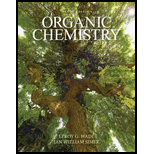
Concept explainers
(a)
To determine: The correct name for the given compound.
Interpretation: The correct name for the given compound is to be stated.
Concept introduction: The
(b)
To determine: The correct name for the given compound.
Interpretation: The correct name for the given compound is to be stated.
Concept introduction: The IUPAC nomenclature of organic compound is a method used for naming organic chemical compounds as recommended by the International Union of Pure and Applied Chemistry (IUPAC). Alkenes and alkynes are unsaturated hydrocarbons and are named by identifying the longest chain of carbon atoms that contain double or triple bond, their names end by adding suffix –ene and –yne to the parent hydrocarbon.
(c)
To determine: The correct name for the given compound.
Interpretation: The correct name for the given compound is to be stated.
Concept introduction: The IUPAC nomenclature of organic compound is a method used for naming organic chemical compounds as recommended by the International Union of Pure and Applied Chemistry (IUPAC). Alkenes and alkynes are unsaturated hydrocarbons and are named by identifying the longest chain of carbon atoms that contain double or triple bond, their names end by adding suffix –ene and –yne to the parent hydrocarbon.
(d)
To determine: The correct name for the given compound.
Interpretation: The correct name for the given compound is to be stated.
Concept introduction: The IUPAC nomenclature of organic compound is a method used for naming organic chemical compounds as recommended by the International Union of Pure and Applied Chemistry (IUPAC). Alkenes and alkynes are unsaturated hydrocarbons and are named by identifying the longest chain of carbon atoms that contain double or triple bond, their names end by adding suffix –ene and –yne to the parent hydrocarbon.
(e)
To determine: The correct name for the given compound.
Interpretation: The correct name for the given compound is to be stated.
Concept introduction: The IUPAC nomenclature of organic compound is a method used for naming organic chemical compounds as recommended by the International Union of Pure and Applied Chemistry (IUPAC). Alkenes and alkynes are unsaturated hydrocarbons and are named by identifying the longest chain of carbon atoms that contain double or triple bond, their names end by adding suffix –ene and –yne to the parent hydrocarbon.
(f)
To determine: The correct name for the given compound.
Interpretation: The correct name for the given compound is to be stated.
Concept introduction: The IUPAC nomenclature of organic compound is a method used for naming organic chemical compounds as recommended by the International Union of Pure and Applied Chemistry (IUPAC). Alkenes and alkynes are unsaturated hydrocarbons and are named by identifying the longest chain of carbon atoms that contain double or triple bond, their names end by adding suffix –ene and –yne to the parent hydrocarbon.
Trending nowThis is a popular solution!

Chapter 7 Solutions
Organic Chemistry (9th Edition)
- 8. Give the IUPAC name for each alkene. CH3 CH2CH,CH3 Br а.arrow_forwardGive the IUPAC name for each compound. CH3 CH2CH3 Br a. PHCH(CH3)2 b. С. d.arrow_forwardName each compound in which the benzene ring is best treated as a substituent. CH3 a. CH3-CH-CH,-CH-CH,-CH–CH,-CH; CH,-CH3 b. CH,-CH-CH=CH-CH,-CH,–CH,-CH, c. CH3-C=C-CH-CH-CH-CH2-CH3 CH3 CH3arrow_forward
- What reagent is necessary to complete the reaction? CH3-CH2-CH-C-OH ? CHỊCH,CH C-0- Na* CH3 CH3 NaO O NaCl O Na O NaOH + H₂Oarrow_forwardIndicate the product obtained by reacting A and B. A || H3C-S-CH₂ Na* || CH 3 B CH2. C. CH3 H3C CH3arrow_forwardA. Give the IUPAC name for the following compounds. OH NH2 OCH¿CH2CH3 CIarrow_forward
 ChemistryChemistryISBN:9781305957404Author:Steven S. Zumdahl, Susan A. Zumdahl, Donald J. DeCostePublisher:Cengage Learning
ChemistryChemistryISBN:9781305957404Author:Steven S. Zumdahl, Susan A. Zumdahl, Donald J. DeCostePublisher:Cengage Learning ChemistryChemistryISBN:9781259911156Author:Raymond Chang Dr., Jason Overby ProfessorPublisher:McGraw-Hill Education
ChemistryChemistryISBN:9781259911156Author:Raymond Chang Dr., Jason Overby ProfessorPublisher:McGraw-Hill Education Principles of Instrumental AnalysisChemistryISBN:9781305577213Author:Douglas A. Skoog, F. James Holler, Stanley R. CrouchPublisher:Cengage Learning
Principles of Instrumental AnalysisChemistryISBN:9781305577213Author:Douglas A. Skoog, F. James Holler, Stanley R. CrouchPublisher:Cengage Learning Organic ChemistryChemistryISBN:9780078021558Author:Janice Gorzynski Smith Dr.Publisher:McGraw-Hill Education
Organic ChemistryChemistryISBN:9780078021558Author:Janice Gorzynski Smith Dr.Publisher:McGraw-Hill Education Chemistry: Principles and ReactionsChemistryISBN:9781305079373Author:William L. Masterton, Cecile N. HurleyPublisher:Cengage Learning
Chemistry: Principles and ReactionsChemistryISBN:9781305079373Author:William L. Masterton, Cecile N. HurleyPublisher:Cengage Learning Elementary Principles of Chemical Processes, Bind...ChemistryISBN:9781118431221Author:Richard M. Felder, Ronald W. Rousseau, Lisa G. BullardPublisher:WILEY
Elementary Principles of Chemical Processes, Bind...ChemistryISBN:9781118431221Author:Richard M. Felder, Ronald W. Rousseau, Lisa G. BullardPublisher:WILEY





